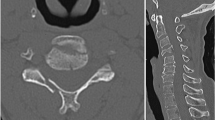Abstract
Purpose
To verify the clinical applicability of a modified classification system in distractive-extension cervical spine injury that reflects the degrees of soft tissue damage and spinal cord injury while complementing previous Allen classification and subaxial cervical spine injury classification (SLIC) system.
Methods
A total of 195 patients with cervical spine distraction–extension (DE) injury were retrospectively classified. We added stages IIIA (with concomitant spinal cord injury without bony abnormalities) and IIIB (with concomitant additional soft tissue swelling) to the existing stages I and II of the Allen classification. We also supplemented the SLIC system by refining and assigning scores to bony morphology and soft tissue damage. The previous and proposed classification systems were compared by analyzing their scoring performances in terms of clinical features and prognosis.
Results
The Allen classification yielded 153 and 42 patients with stage 1 and 42 stage 2 injuries, respectively. Patients classified according to the proposed system were stratified as follows: stage I, 58; stage II, 27; stage IIIA, 33; and stage IIIB, 77. Regarding neurological symptoms and prognosis, stages IIIA and IIIB were poorer than stage I but significantly better than stage II (P < 0.05). On the SLIC system, 146 patients scored ≥5; and 37 and 12 patients scored 4 and ≤3 points, respectively, whereas the numbers of patients who scored ≥5, 4, and ≤3 points on the modified SLIC system were 170, 21, and 4, respectively.
Conclusions
The proposed classification and scoring system to complement the Allen classification and SLIC system with respect to the degrees of soft tissue damage and spinal cord injury is considered effective for diagnosing and determining therapeutic directions and prognosis in cases of cervical spine extension injury.


Similar content being viewed by others
References
Vaccaro AR, Klein GR, Thaller JB, Rushton SA, Cotler JM, Albert TJ (2001) Distraction Extension injuries of the cervical spine. J Spinal Disord 14:193–200
Glaser JA, Jaworski BA, Cuddy BG, Albert TJ, Hollowell JP, McLain RF, Bozzette SA (1998) Variation in surgical opinion regarding management of selected cervical spine injuries: a preliminary study. Spine 23:975–982 (discussion 983)
Rea G (1996) Sub-axial injuries of the cervical spine. In: Menezers Sonntag (ed) Principles of spinal surgery. McGraw-Hill, New York, pp 885–898
Chapman JR, Anderson PA (1997) Cervical spine trauma. In: Frymoyer J (ed) The adult spine: principles and practice. Lippincott-Raven, Philadelphia, pp 1245–1295
Kwon BK, Vaccaro AR, Grauer JN, Fisher CG, Dvorak MF (2006) Sub-axial cervical spine trauma. J Am Acad Orthop Surg 14:78–89
Allen BL Jr, Ferguson RL, Lehmann TR, O’Brien RP (1982) A mechanistic classification of closed, indirect fractures and dislocations of the lower cervical spine. Spine 7:1–27
Song KJ, Kim GH, Lee KB (2008) The efficacy of the modified classification system of soft tissue injury in extension injury of the lower cervical spine. Spine 33:488–493
Vaccaro AR, Hulbert RJ, Patel AA, Fisher C, Dvorak M, Lehman RA Jr, Anderson P, Harrop J, Oner FC, Arnold P, Fehlings M, Hedlund R, Madrazo I, Rechtine G, Aarabi B, Shainline M (2007) The subaxial cervical spine injury classification system: a novel approach to recognize the importance of morphology, neurology, and integrity of the disco-ligamentous complex. Spine 32:2365–2374
Middendorp JJ, Audigé L, Bartels RH, Bolger C, Deverall H, Dhoke P, Diekerhof CH, Govaert GA, Guimerá V, Koller H, Morris SA, Setiobudi T, Hosman AJ (2013) The subaxial cervical spine injury classification system: an external agreement validation study. Spine J 13:1055–1063
Marino RJ, Barros T, Biering-Sorensen F, Burns SP, Donovan WH, Graves DE, Haak M, Hudson LM, Priebe MM (2003) International standards for neurological classification of spinal cord injury. J Spinal Cord Med 26:S50–S56
DeBehnke DJ, Havel CJ (1994) Utility of prevertebral soft tissue measurements in identifying patients with cervical spine fractures. Ann Emerg Med 24:1119–1124
Song KJ, Choi BW, Park CI, Lee KB (2015) Prognostic factors in distractive extension injuries of the subaxial cervical spine. Eur J Orthop Surg Traumatol 25 (Suppl 1):S101–S106
Song KJ, Moon YJ, Lee KB (2012) Clinical analysis of lower cervical spine injury according to injury mechanism: data of 277 surgical patients. J Korean Orthop Assoc 47:264–270
Song KJ, Choi BW, Lee KB, Chang H (2012) The relationship between soft tissue damages and neurologic deficits in distractive extension injury of the lower cervical spine. J Korean Orthop Assoc 47:15–20
Miyanji F, Furlan JC, MBA M, Aarabi B, Arnold PM, Fehlings MG (2007) Acute cervical traumatic spinal cord injury: MR imaging findings correlated with neurologic outcome—prospective study with 100 consecutive patients. Radiology 243:820–827
Fehlings MG, Rao SC, Tator CH, Skaf G, Arnold P, Benzel E, Dickman C, Cuddy B, Green B, Hitchon P, Northrup B, Sonntag V, Wagner F, Wilberger J (1999) The optimal radiologic method for assessing spinal canal compromise and cord compression in patients with cervical spinal cord injury. II. Results of a multicenter study. Spine 24:605–613
Author information
Authors and Affiliations
Corresponding author
Ethics declarations
Conflict of interest
None.
Rights and permissions
About this article
Cite this article
Song, KJ., Lee, SK., Ham, DH. et al. Limitation of previous Allen classification and subaxial cervical spine injury classification (SLIC) system in distractive-extension injury of cervical spine: proposal of modified classification system. Eur Spine J 25, 74–79 (2016). https://doi.org/10.1007/s00586-015-4240-3
Received:
Revised:
Accepted:
Published:
Issue Date:
DOI: https://doi.org/10.1007/s00586-015-4240-3




